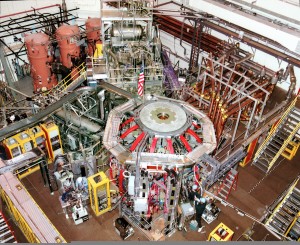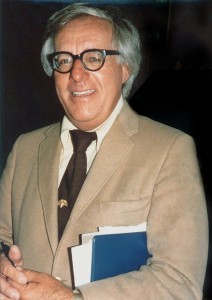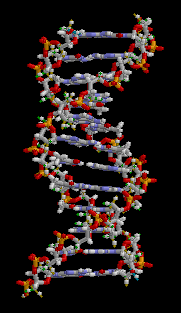Solar Airplane Upgrading For World Tour
Yesterday, I wrote an article about the energy we could get out of a fusion reactor in development. Today, it’s about the energy we could get from a fusion reactor already in service: the Sun.
Solar power lacks the flair of fusion, and I’m afraid the story of a plane that cruises at 43 mph probably won’t do much to help that along, but there’s a lot to the Solar Impulse that captures the imagination. There’s its magnificent wingspan, for instance:
That’s a 208 feet wingspan folks, dwarfing many airliners and bombers. The kicker is that the whole thing weighs in at a max takeoff weight of two tons – 4,400 pounds. It’s empty weight is about the same as your car’s. Think for a moment about the brilliant design and fine construction keeping the weight down must have required. There’s no two ways about it – just the size-to-weight issue makes this a marvel of engineering.
A Step Forward for Fusion Power
Could it be that, in my lifetime, we will at least develop viable fusion power? I mean, the various space agencies are killing my hope that we’ll send someone to Mars in the next fifty years, but maybe we’re all desperate enough for energy that we can pull this colossal trick off, and catapult civilization to the next stage?
University of Tennessee researchers have successfully tested the technology that keeps the central solenoid of a tokamak fusion reactor stable. The actual solenoid for the ITER (International Thermonuclear Experimental Reactor) in France can now be built by General Atomics in San Diego. If successful, ITER will start running deuterium-tritium reactions in 2026. The expectation is that it will be able to output ten times more power than it inputs. Considering fusion reactors up till now have consumed more than they produce, this is a big leap.
Just to orient ourselves, this is a tokamak-type reactor from the outside:
And the internal torus surrounding the solenoid:
American Warships (2012) Review
I was pleasantly surprised by the syfy channel movie called American Warships shown on Saturday 19th May. Syfy channel makes it a regular practice to show their low budget knock-offs when some big-budget Hollywood extravaganza is appearing. Recent examples are their versions of Thor, Battle for Los Angeles and War of the Worlds.
American Warships is a knockoff of Battleship (read my previous review) without being constrained by the board-game. It stars Mario Van Peebles and Carl Weathers, who both give credible if somewhat stilted performances – what can you expect from military types anyway. The director is someone named, believe or not, Thunder Levin who had last directed a movie in 2008 called Mutant Vampire Zombies from the ‘Hood’ – no, I didn’t make that up either!
The premise is that mysterious stealth ships have taken out the USS Enterprise carrier group with EMP weapons that cripple all the electronics and sophisticated missile technology that destroy the ships and nearby airbases in South Korea. The North Koreans and Chinese are suspected and a nuclear war is imminent. Of course, things are not so simple (spoiler alert……). It is really aliens who are trying to create a situation whereby humanity destroys itself and save them the trouble.
Ray Bradbury’s Legacy
Ray Bradbury passed away yesterday, June 5th 2012, at the age of 91. He was a widely influential author of science fiction and fantasy and among the last writers from the heyday of science fiction in the 1950s. He is best known for Fahrenheit 451, the dystopian novel that seems ever more prescient with every year.
I have not read much Ray Bradbury, mainly because, as he himself noted, Fahrenheit 451 was his only science fiction novel. According to Bradbury, the Martian Chronicles and other similar works should be classified as fantasy, since they cannot happen, and I tend to agree with him. He thought of himself as a myth-maker and that was his entire aim, because “myths have staying power” and he explicitly wanted to live forever through his work.
One consistent characteristic of Ray Bradbury endears him to me, though, and that’s his ever-present skepticism about technology. Unlike many science fiction writers, he did not assume that life in a world with advanced technology would be a wonderful thing. On explaining why he opposed turning Fahrenheit 451 into an e-book (which would have been highly ironic given the book’s premise), he said, “We have too many cellphones. We’ve got too many internets. We have got to get rid of those machines. We have too many machines now.” I don’t agree with him, but I sometimes think we’re plunging into technology without really thinking about what it’s doing to us, and whether it is really benefiting us. It’s like using a hammer without being aware that you might accidentally crush your finger while holding the nail. Yes, the technology is useful, but no one ever mentions the drawbacks.
On the Persistence of Nano-waste
First of all, a clarification. The prefix nano- seems to get attached to all sorts of stuff these days, especially in the science press, and it’s just begging for confusion. Nano-waste simply refers to synthetic particles on the nanometer scale that are engineered for some purpose, and are discarded along with the product when it has outlived its usefulness. It is nanotechnology in the broadest sense of the term – and we really need to be clearer about what we mean by nanotechnology going forward – though the conclusions reached by Walser, T. et. al. in the journal Nature Nanotechnology certainly has relevance to applications of small-scale computing (what we normally think about when we discuss nanotech) as well.
The particular problem raised by Walser, et al is that cerium oxide, a non-toxic synthetic used in catalytic converters, neither burns up nor biodegrades, so that it just sticks around and may eventually end up in our water supply and food cycle. Try to send it through an incinerator, and it will end up with the residue and tossed into a landfill, where it will persist indefinitely.
The good news is that cerium oxide is non-toxic and doesn’t escape into the atmosphere through the incineration process. The bad news is that it is not the only synthetic we have or are developing, and in many cases the environmental impact of the new compounds is not adequately tested. Once researchers find a practical use for them, they’re put to work without regard for whether we can get rid of them, or what they might do to us once they end their useful life and wind up in a pile of waste.
DNA Computing – Helix Memory Storage
I don’t think many people have any idea how far we’ve come. Because I like to keep track of scientific and technological developments as part of writing science fiction, I have a better idea than most, but then a story like this one comes across my desktop and I’m left in disbelief.
It has only been sixty years since the structure of DNA was understood, and now researchers at Stanford University have figured out how to write, read, and rewrite bits of information on DNA itself, making DNA an information storage device. When I say bits, I mean bits – they haven’t managed a full byte (eight bits) yet.
Still, it’s pretty amazing. They use two proteins – integrase and excisionase – and by getting the balance between the two right, can reliably switch the direction of a section of DNA. The DNA in question was within the chromosomes of the favorite of biological researchers – E. coli.
Don’t Sweep Dark Matter Under the Rug!
Ever since astrophysicists discovered a discrepancy between the mass of the observed matter in galaxies and gravitational effects that gave them structure and hypothesized the existence of dark matter, some spoil-sports have tried to insist that dark matter doesn’t exist at all. Numerous theories have tried to hide dark matter – including attempts to modify gravitational theory itself. The latest blow against dark matter came from a team of astronomers who simply measured stars in the Milky Way and concluded that their motion could be entirely explained by visible mass – that there was no need for dark matter.
Why are people so hostile to the idea of dark matter? Well, maybe it’s because it compromises more than eighty percent of the matter in the universe (it has to, in order to have the gravitational effect that it does), yet we can’t see it and don’t know anything about it. It’s an elephant in every room and we can’t even see it there. That sort of thing tends to frustrate people – especially people who like to think that they already know everything about the universe.






